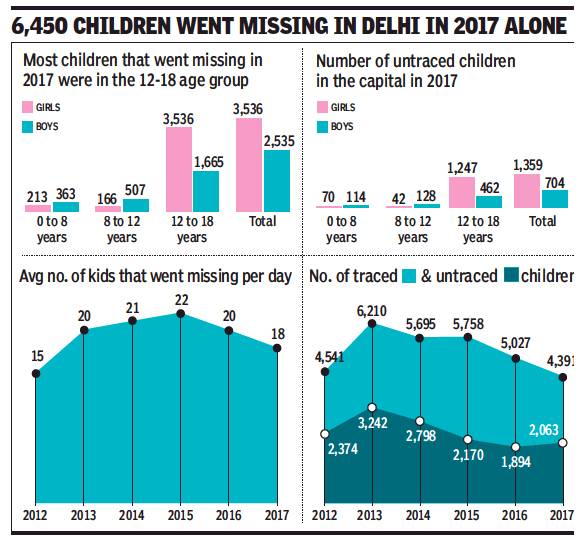Missing children: India
This is a collection of articles archived for the excellence of their content. |
Contents |
Delhi
Children, missing
2008-14, untraced children
See graphic:
2008-14, Children who went missing in Delhi, and those who remained untraced

2012-17: two-thirds remain untraced

Those who are traced;
The age groups in which children mostly go missing.
From: Somreet Bhattacharya, 18 kids go missing daily in Delhi, 2/3rd of them remain untraced, September 26, 2018: The Times of India
Study By NGOs Finds Girls In Age Group Of 12-18 Years Are Most Vulnerable
Preeti and Durga (names changed), two sisters from Aman Vihar in Rohini who went missing from outside their home in April 2017, were reunited with their parents a few months later following sustained efforts by the police and an NGO. However, not all are so lucky — 66% of the children who go missing in Delhi every year remain untraced.
A study conducted by Child Rights and You (CRY) and Alliance for People’s Rights (APR) has found that 6,450 children went missing in Delhi in 2017. Out of these, 3,915 were girls and 2,535 boys. At an average of 18 children per day, this may look like an improvement from the 2015 count of 22, but it actually puts Delhi among the states reporting very high numbers of missing children.
The study, based on RTI replies from Delhi Police and National Crime Records Bureau (NCRB), also reveals that in the age group of infant to 12 years, more boys go missing than girls, hinting at a trend of demand for male children for adoption in the capital. In 2017, 379 girls in this age group were reported missing against 770 boys.
However, the pattern changes in the age group of 12-18 years, when more girls are reported missing. In 2017, the count was 3,536 girls against 1,665 boys. “The phenomenon of elopement at this age cannot be ignored” but the authorities don’t have any data to establish such a connection, states the report.
Reena Banerjee, state convener of APR, said forming a strong security net around children could be a way out of such a situation. “Over the past two years, there have been close to no instance of a missing child in the communities that have adopted the concept of vigilance groups,” she said.
The study also lists the top 20 police stations that recorded the highest number of missing cases till 2016. At 162, Shahbad Dairy is at the top, followed by Narela (138) and Jaitpur (125).
In 2017, the police traced 4,391 children compared to 5,027 in 2016. However, the study claims that an analysis shows that the children who might have been rescued were not necessarily reported missing in that particular year. Last year, just eight-10 missing children could be traced within a year.
Soha Moitra, regional director (north) of CRY, said that ensuring inter- and intra-state coordination in investigation, rescue and rehabilitative mechanism was essential to deal with the problem. “Investing in adequate resources and recruiting trained personnel at every level are the need of the hour.”
She added that strengthening various mechanisms — police patrolling, face recognition softwares, hue-andcry notices, hoardings and banners of missing children, installation of CCTV cameras — could help in increasing the rate of recovery.
2018-22
More than 47,000 children are missing in India, according to the latest data from the National Crime Records Bureau (NCRB), with 71.4 per cent of these being minor girls.
NCRB figures for the five years up to 2022 also show a mostly rising trend in the figures of missing children — a spike of 7.5 per cent in 2022 in comparison to 2021, a significant surge of 30.8 per cent in 2021 against 2020, a drop of 19.8 per cent in 2020 against 2019 and again an increase of 8.9 per cent in 2019 against 2018 and of 5.6 per cent in 2018 against 2017.
State authorities have also found or traced many missing children, but the gap in the figures continues to remain unbridged.